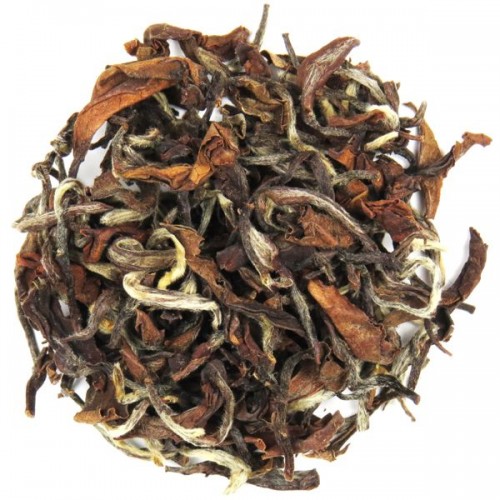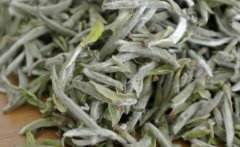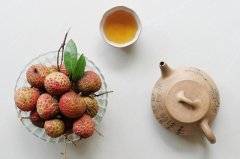Where does the Oriental Beauty's name come from? what is the good effect of drinking Oriental Beauty Tea?
Oriental Beauty, Baihao Oolong Tea and Pengfeng Tea are a kind of unique famous tea. Traditionally, it grew up in Hsinchu County in northern Taiwan. With undulating mountains and mild climate, it is an ideal place to grow tea. Residents transferred from Chinese mainland in the Ming Dynasty probably began to plant tea trees here at that time, and these earliest tea trees may include varieties that later became "oriental beauties".
It was not until 1933 that Oriental Beauty won a prize in a tea competition that it was introduced into the commercial market. At that time, the Taiwan government was trying to improve the quality of tea exports, and tea competitions were an excellent way to reward farmers who produced high-quality tea. The first buyers of "Oriental Beauty" included the governor's office, and the price of tea was so high that the boast of proud farmers inspired the name "Prague Tea".
A smell worth showing off.
The secret of this charming tea does not lie in its variety or origin, although they do contribute. On the contrary, it was the bite of the green leafhopper that turned this summer's harvest into an award-winning wine. Although this must have been unexpected at the time, modern science has revealed the chemical effects of these attacks. This naturally occurring sweetness is a direct by-product of plant natural defense because it produces a unique enzyme to attract aggressive leafhopper predators. Today, other tea farmers have also taken advantage of this effect to produce all kinds of tea bitten by insects.
Moth-eaten tea is often called "honey fragrance". Well-made honey-scented tea has a unique honey aroma and a unique sweetness, which is caused by defensive enzymes released by plants. In the tea tasting competition in 1933, the taste of the tea must have been completely unique and unexpected, because the obviously damaged tea would be discarded by most other growers. In addition, Oriental Beauty is seriously oxidized, which brings undeniable fruit attention to this and other Mi-scented teas.
Today, oriental beauties have many grades, just like any kind of tea. The best thing to do is to use the tender leaves harvested in summer. The leaves of this crop are strong enough to withstand rolling and oxidation, but also young enough, with relatively high carbohydrate content and low bitterness. The result is a smooth brew with a rich taste.

Reputation and reality
It may not be surprising to learn that this kind of tea, which is famous for its high price, is often expensive. In fact, this is perfectly reasonable: the yield of crops bitten by insects may be reduced by more than half because of the damage to leaves. Leaves that have been bitten too much will be bitter, and the smell of incense will be completely offset by a rain before harvest. This is a kind of tea with small natural supply and enjoys a high reputation at home and abroad.
Unfortunately, this has led to a surge in imitation, and we have seen other famous varieties. Low-level "Oriental Beauty" may be made from broken leaves, or larger, more mature leaves, and leaves bitten by bugs have less impact. As Taiwan's leafhoppers have recently been found to be the same as Chinese leafhoppers, "Oriental Beauty" is now produced in the mainland, where differences in provenances and varieties can produce real taste differences. Some imitations of Oriental Beauty tea may not even be bitten by insects at all, so they have more floral and botanical flavors.
Finally, even the high-quality traditional "Oriental Beauty" often lacks the aftertaste and depth of other teas in Taiwan, such as those grown at high elevations. This is only the role of provenance and harvest season, because traditional summer leaves grow rapidly and do not have much time to form complex flavor compounds. In a word, we seldom come across a kind of tea whose name is worth the asking price.
However, our recent shopping trip brought us an unexpected exception: in the high-altitude area of Alishan, this traditional style is interpreted in a modern way under the modern name "the Beauty of the East". It is not the leafhopper that is bitten by aphids, but the crop, but the enzyme reaction in the plant is basically the same, producing the unique sweetness and strong fruit aroma famous for the beauty of the East. The traditional oolong tea variety that grows near the top of the mountain, the bright honey top notes highlight the long-lasting aftertaste, surprisingly rich, no astringency. We were so impressed by this tea that we made it part of our exclusive series of red labels.
Important Notice :
前街咖啡 FrontStreet Coffee has moved to new addredd:
FrontStreet Coffee Address: 315,Donghua East Road,GuangZhou
Tel:020 38364473
- Prev

A brief introduction to the names of the three major beverage tea varieties in the world the characteristics of Yunnan Jinsi Yunnan black tea
We often discuss four factors for each kind of natural tea to develop its unique flavor. Variety, harvest date, origin and technology all play a role in shaping the characteristics of finished tea. However, the weight of these factors in defining quality and taste may vary from category to category or even from tea to tea. In order to understand the impact more clearly, tasting some teas that rely heavily on a single factor can help
- Next

Why Earl black tea and litchi black tea have fragrance do they use essence? Detailed explanation of the production method of seasoned tea
Seasoned tea is the most popular all over the world. The famous jasmine tea, Masala tea and Earl Grey Tea are all made of tea leaves and added flavor. Despite occasional purist snobbishness, flavored tea ranges in quality from mass-produced tea bags at grocery stores to whole-leaf tea bags seasoned with organic ingredients. To check the quality of seasoned tea, it is important to ask for extra
Related
- The milk tea cup becomes smaller?! Overlord Tea Girl launches a new "Return to Yunnan" series
- Accused of selling counterfeit and high-priced coffee beans! Well-known boutique coffee brand "Oukelao" bowed and apologized!
- How to make espresso dumplings? Can I eat coffee and glutinous rice balls together?
- Save the unformed and stagnant powder cakes in one second! What is the problem with stagnant water in the powder bowl of the espresso machine?
- What does hand-brewed coffee stop mean? Why is it not recommended to make coffee by hand?
- Is it normal to smell like coffee? Why does coffee smell like alcohol? What's wrong with the strong smell of cold extract ice dripping ice brewed coffee?
- How to solve the problem that hand-brewed coffee extraction takes too long? Why is the water flowing so slowly when making coffee?
- The main points of making Australian white coffee, the proportion details, how does Australian white properly foam and blend the flowers?
- Can ice water make cold extract coffee? What is the difference between room temperature water and ice water for making cold coffee?
- What milk is best for making latte and white Dirty coffee? What is the difference between different brands of fresh milk and pure milk for making coffee?

